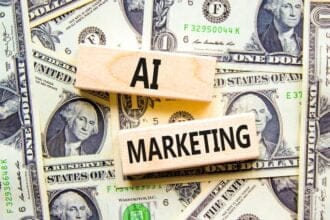More sales people are using AI to reach their goals. HubSpot reports that nearly one out of five use AI to generate content alone. However, there are other benefits of using AI in sales. AI can help with deriving insights from point-of-sales data.
As an AI expert with over five years of experience in point-of-sale product development, I’ve had the opportunity to delve into the data captured by POS software and explore how it can be utilized to help businesses create a competitive advantage. POS systems generate massive volumes of data daily, but this raw information holds limited inherent value. Let’s discover how business leaders can uncover insights from this data by implementing artificial intelligence.
How POS Data Analytics Can Bring Benefits to Your Business
Every business needs to make data-driven decisions if it is going to succeed. With basic analytics, you can see how much people are buying, how much money you’re making from customers, what products each customer purchases, etc. Implementing AI features to POS systems brings this to the next level and allows you to predict trends, highlight anomalous transactions or customer behavior, and more.
When that data is collected, organized, and presented to business leadership correctly, all sorts of benefits follow. You can better track how a new product performs when it launches. Demand forecasting helps you stock intelligently when the time is right. It can also help you build better relationships with your customers through personalized product recommendations.
Using the Power of AI for POS Data Analytics
Advanced AI data analysis techniques make extracting valuable insights from raw POS data more efficient, leading to much more intelligent decision-making. All of this leads to happier customers, greater revenue, and more time and energy to focus on other key areas of your business. Let’s go into more detail about some of the techniques that result from POS data analytics that can benefit your business.
Demand Forecasting
One of the first things that comes to mind when trying to figure out how to develop a demand forecasting solution is historical sales. That’s an important piece of the puzzle, but it’s not everything. We need more information to determine when certain product categories are going to start flying off the shelves. Consider factors like geography, marketing, competition, state of the economy, and customer interest trends. All of these have an impact, and AI can comb through all that data much more efficiently than we can.
According to Algonomy.com, groceries with demand forecasting models can reduce their out-of-stock instances by three quarters. This also reduces inventory costs by 10%.
To accomplish this, a business and the software development team that they’re working with have to agree on success metrics. Without a measurable data point that can indicate success, it’s almost impossible for the AI to identify anything meaningful from the data it’s analyzing. It boils down to this question: what’s valuable to you in demand forecasting?
Most importantly, data quality is the most critical component of demand forecasting and any AI implementation. That data has to be cleaned, audited for gaps and anomalies, double-checked to make sure it’s relevant, and formatted in a way that’s easy for the AI to understand. Machine learning models could lead to poor results if the data that is used for training the model is not relevant to the data that will be used in the production environment. Every project will have its own challenges and good data scientists will know how to approach those problems.
Price Optimization
One of the critical pillars of market competition is price optimization. Finding the best possible prices at any given time requires careful study of consumer behavior, competitor analysis, and other market trends. Each of these points of study are perfect candidates for AI analysis. When combined with other techniques like demand forecasting, pricing optimization strategies can be even more effective.
Developing a data-driven dynamic price model with AI follows this general process:
- Real-Time Data Analysis: Monitor POS data, market trends, and customer purchasing behaviors
- Demand Forecasting: Forecast product demands to use them as one of parameters for price optimization
- Combine and Implement: Pool together insights from relevant sources for developing the AI price optimization model
- Monitor and Pivot: Keep track of your performance and adjust the model as needed
Personalized pricing is another strategy where a business adjusts prices for individual shoppers based on their purchasing history.
Choosing the Right ML Model
One of the most important choices business leaders need to make when developing a dynamic pricing system is developing the right machine learning model. The ML model you choose must match your pricing strategy’s objectives.
| ML Model | Pros | Cons | Best Used For |
| Linear Regression | Easy implementation and interpretation. Great for understanding variable relationships. | Assuming linear relationships may not hold in complex dynamic pricing situations | If relationships in your pricing strategy are linear |
| Decision Trees | Non-linear patterns | Overfitting issues Lacks robustness | Interoperability, clear decision boundaries |
| Random Forests | Avoids overfitting better than decision trees. Large feature capacity | More complex and computationally intensive | Complex dynamic pricing problems with many features and non-linear relationships |
| Gradient-Boosting Machines | Predictive accuracy | Prone to overfitting and sensitive to outliers | When performance is a priority |
| Neural Networks | Highly flexible and capable of modeling complex relationships, including textual data processing | Requires a lot of data and computational power. Difficult to interpret. | Overly complex dynamic pricing systems where the model needs to learn intricate patterns from large datasets |
For example, linear regression is simple and easy to interpret. However, it can struggle with nonlinear relationships. Neural networks, on the other hand, are great at intricate patterns but usually require a lot more computational power. The choice of the right model depends on your business goals and product requirements, and there is no one-fit-all solution.
Enhanced Personalization for Customers
Complex client segmentation is one of the most recognized strengths of AI in the retail and hospitality industries. Marketing campaigns can be completely transformed by AI’s ability to recognize customer purchasing patterns, interests, and other valuable data. With accurate and personalized product recommendations, businesses can prioritize building customer loyalty.
Recommendation models when paired with POS systems increase sales for businesses because they provide an improved, personalized experience at checkout. This doesn’t just have to happen in online storefronts. Customers can receive personalized product recommendations at self-checkout too. Cashiers can also have product recommendations displayed on their register screens to upsell products to customers in person.
When personalized product recommendations are provided consistently and accurately match customer preferences, customer loyalty grows. This leads to repeat purchases and makes business revenues more stable.
Leverage Point of Sale Data with AI
Data from your POS systems is powerful when used correctly. If your retail or hospitality business is considering implementing demand forecasting, price optimization, or enhanced product recommendation systems based on that data, the best place to start is to determine what you are trying to achieve, and what data you have right now.
Consulting with AI and data science experts is the best place to start getting those questions answered. Experienced data and AI professionals can examine the data you have and determine the best approaches to take to ensure your success.











